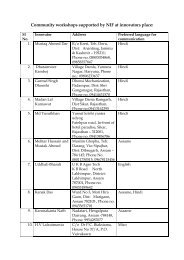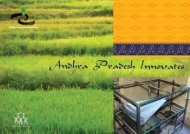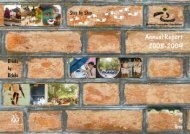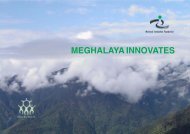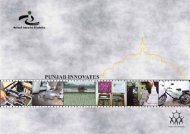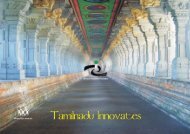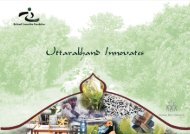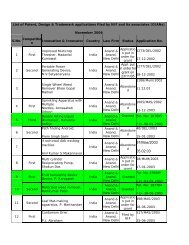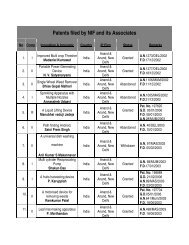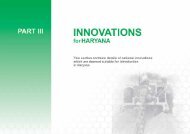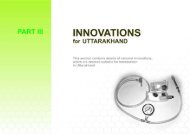PART-I Innovation from West Bengal - National Innovation Foundation
PART-I Innovation from West Bengal - National Innovation Foundation
PART-I Innovation from West Bengal - National Innovation Foundation
Create successful ePaper yourself
Turn your PDF publications into a flip-book with our unique Google optimized e-Paper software.
PREFACE<strong>National</strong> <strong>Innovation</strong> <strong>Foundation</strong> has been has been pursuing pursuing the mission theof mission making of India making innovative India innovative and a creative and society a creative since society 2000with since the 2000 active with the support active support of Department of Department of Science of Science andand Technology, Government Government of India. of India. We have We not have been not equally beensuccessful equally successful in scouting scouting and documenting and documenting innovations innovations andtraditional and traditional knowledge knowledge practices practices in every in state. every state.Thanks to the support of of volunteers of of Honey Bee Bee network, wehave we have been been able to able discover to discover many unsung many unsung heroes and heroes heroines andof heroines our society of who our have society solved who local have problems solved without local any problems outsidehelp. without any outside help.Despite various constraints, NIF has put together a small bookcelebrating creativity, innovations and and traditional knowledge knowledge <strong>from</strong>Gujarat. <strong>from</strong> <strong>West</strong> I am <strong>Bengal</strong>. conscious I am of conscious its limitation of its in terms limitation of coverage in termsand of coverage outreach. and But outreach. if we could But uncover if we could so many uncover examples so many ofexamples of the ability of local communities and individualsto solve problems on their own without outside help, howthe much ability more of local can communities be done if state and and individuals private to sector solve agencies problemson join their hands own without NIF outside actively. help, how much more can be doneif state and private sector agencies join hands with NIF actively.I invite the state government and its various organs to activelysupport our quest to uncover many more creative communitiesand individuals in in rural and and urban areas. NIF NIF will will then then help help inbuilding in building value value chain chain around around them. them.The book is divided in three parts. The mechanical innovationsdeveloped by innovators <strong>from</strong> <strong>from</strong> Gujarat <strong>West</strong> are <strong>Bengal</strong> covered are in covered part one. inSelected part one. examples Selected of examples herbal traditional of herbal knowledge traditional are knowledge given inpart are two. given The in innovations part two. The <strong>from</strong> innovations other parts of <strong>from</strong> the country other parts suitable offor the the country development suitable of for Gujarat the development are given in of part <strong>West</strong> three. <strong>Bengal</strong> aregiven in part three.By no stretch of imagination, could we claim that we haveachieved By no stretch a great of deal. imagination, We have could merely we made claim a that simple we point. haveachieved a great deal. We have merely made a simple point.There are a large number of knowledge rich people whoWEST BENGAL INNOVATES 4
WEST BENGAL INNOVATESThere may not are a have large been number educated of people much, who may may not in have fact beeneducated economically much, poor may also, in fact but be still economically have the ability poor also, to solve but still ahave few problems the ability so to solve well. a few problems so well.The challenge really is to is work to work out a out synergy a synergy so that so no creative that novoice creative remains voice unheard, remains and unheard, no solution and remains no solution localized remains andunrecognized. localized and By unrecognized. adapting public By policy adapting support public of grassroots policy ininnovators support of grassroots and traditional innovators knowledge and holders, traditional we knowledge can makeeconomic holders, we development can make economic process more development inclusive and process sustainable. moreinclusive and sustainable.This book on innovations has been compiled at the request ofDr This Vijay book Kelkar, on innovations Chairman, Finance has been Commission compiled at and the Member, requestGoverning of Dr. Vijay Council Kelkar, of Chairman, the <strong>National</strong> Finance <strong>Innovation</strong> Commission <strong>Foundation</strong> andas Member, a tribute Governing to the creativity Council and innovation of the <strong>National</strong> grassroots. <strong>Innovation</strong> Thispresentation <strong>Foundation</strong> as is a part tribute of a to series the creativity of innovation and innovation compendiumatprepared grassroots. for This each presentation State of India. is part We hope of a series this will of be innovation followedcompendium prepared for each State of India. We hope thiswill be followed up in the form of concrete policy andup institutional the form initiatives of concrete in policy each and State institutional to empower initiatives creative ineach people State to improve to empower the creative quality of people life of to common improve the people quality and oflife thus of promote common inclusive people and growth. thus promote inclusive growth.It is is my my belief that that such such examples will act will as act spur as spur for other for other Stategovernment State government departments departments to look for to creative look for efforts creative of their efforts staff ofand their users staff at and ground users level. at I hope ground that level. NIF will I have hope the that opportunity NIF willto have work the closely opportunity with the to State work closely government with the in future State government and expandknowledge in future and base, expand add knowledge value to selected base, technologies add value to and selected helpthem technologies diffuse through and help commercial them diffuse and through non commercial social andchannels non-commercial for improving social the channels livelihood for of the improving majority the of the livelihood people.of the majority of the people.R. A. Mashelkar, FRSChairperson, Governing Council<strong>National</strong>R. A. Mashelkar,<strong>Innovation</strong>FRS<strong>Foundation</strong>, AhmedabadChairperson, Governing Council<strong>National</strong> <strong>Innovation</strong> <strong>Foundation</strong>, Ahmedabadmashelkar@nifindia.orgWEST BENGAL INNOVATES 5
WEST BENGAL INNOVATESdevelopment, (c) Business development and Micro Venture, (d)Intellectual Property Rights protection and (e) Dissemination,database development and IT applications.NIF has been entrusted with the responsibility of building a<strong>National</strong> Register of Grassroots <strong>Innovation</strong>s and TraditionalKnowledge. It is not enough to document or disseminate theinnovations or outstanding traditional knowledge. Value additionis very important for harnessing the full potential of the idea.NIF has entered into MOU with CSIR and Indian Council ofMedical Research (ICMR) besides other organizations. CSIRhas allocated funds to support research on grassrootsinnovations in CSIR labs. Similarly, ICMR supportsresearch on such herbal healing knowledge, whichhas not been documented in the classical texts and formalinstitutional literature. NIF also helps in generating a very largepool of open source / public domain technologies. A smallnumber of innovations are also protected by patents andother IPRs.For most innovators, attracting risk capital for convertinginnovations into enterprise is very difficult. They neither canoffer much collateral nor are they able to develop business planor deal with formal R&D system.A Micro Venture <strong>Innovation</strong> Fund (MVIF) has been set up withthe help of SIDBI to provide risk capital for technologies atdifferent stages of incubation. Under single signature, innovatorsare trusted and investments are made to help them commercialisetheir innovations. Most innovators do not make good entrepreneurs.For entrepreneurship, one has to make consistent batch bybatch production of products. Innovators are often incorrigibleimprovisers. They seldom make two things alike. NIF has helpedsuch innovators to license their technologies to third partyentrepreneurs. Most of the licenses have been given to smallentrepreneurs and in a few cases, to medium enterprises.A very elaborate benefit sharing system has been developed,governed by the Prior Informed Consent (PIC) of the knowledgeThe Honey Bee Network strongly believes in sharing knowledge among theproviders of innovations in their own language, which is achieved by publishinglocal language versions of Honey Bee newsletter. It also ensures that a fairshare of benefits arising <strong>from</strong> commercial exploitation of local knowledge andinnovations reaches the innovators and knowledge providers.WEST BENGAL INNOVATES 7
providers. Attempt is made to share benefits not only with theinnovators but also with their communities and for natureconservation. In addition, a small part is kept for contingencysupport to needy innovators, for R&D stakeholders, promotingwomen’s innovations and meeting overhead costs.It is remarkable that grassroots innovations are generating globaldemand, as evident <strong>from</strong> inquiries <strong>from</strong> around fifty-five countriesfor various technologies, NIF has succeeded in commercializingproducts across countries in six continents apart <strong>from</strong> beingsuccessful in materialising thirty cases of technology licensingwith the help of partner agencies.What has it done?With major contribution <strong>from</strong> the Honey Bee Network, NIF hasbeen able to build up a database of more than 1,00,000 ideas,innovations and traditional knowledge practices <strong>from</strong> over 500districts of the country.NIF has filed 182 patents in India and seven in US and one PCTapplication. Out of these, 33 patents have been granted tograssroots innovations in India and four in US. NIF has funded113 projects under MVIF to the extent of Rs.1.3 crores. Hundredsof technologies have diffused through farmer to farmer socialnetwork.NIF has proved that Indian innovators can match anyone in theworld when it comes to solving problems creatively. Where theyperform better than rest is in generating more affordablesustainable solutions by using local resources frugally.Those who see poor only as the consumer of cheap goods, missthe knowledge richness at the grassroots level. The Poor can bethe Providers also.The Grassroots to Global (G2G) model that NIF is propagating isall set to change the way the world looks at the creativity andinnovations at grassroots.How can state government join hands with NIF?a. NIF has no field extension unit nor does it want to haveone. However, state government has several fieldfunctionaries in the field of agriculture, education, industry,rural development, women and child care, forestry, etc.There can be a very fruitful partnership between NIF as asource of innovative ideas and technologies and stateWEST BENGAL INNOVATES 8
“<strong>Innovation</strong> opens up new vistas of knowledge and newdimensions to our imagination to make everyday lifemore meaningful and richer in depth and content”.- Dr. A.P.J. Abdul Kalam“The purpose of innovation is to create a new value foran individual, team, organization or for society at large”.- Dr. R.A. Mashelkar
01<strong>PART</strong> I : INNOVATIONS FROM WEST BENGALA Life Dedicated to <strong>Innovation</strong>sWaland- Amphibious Cycle RickshawNitai Das GuptaMurshidabadThis boat shaped rickshaw, which can accommodate four persons, was developed bythe innovator in 1954. The direction of this rickshaw is controlled by a handle attached tothe front wheel. The speed in water and on land is estimated to be 8 km/hr and 30 km/hrrespectively.5-Gear BicycleThis innovative bicycle having five gears was developed by the innovator in 1958. Twopersons can ride this bicycle. Of the five gears, two gears were specially incorporated toenable a comfortable ride on hilly terrains.WEST BENGAL INNOVATES 12
<strong>PART</strong> I : INNOVATIONS FROM WEST BENGALMotor Cycle Driven AmbulanceTransport of the sick and injured persons to health facilities in rural areas is a majorconcern due to the lack of motorised ambulances. Methods currently used such as carryingon a crude stretcher or in wheel barrows or carts, are slow and uncomfortable, leading tounnecessary delays and discomfort of the patients.To address these problems, the innovator came up with a motorcycle driven ambulanceway back in the seventies. The ambulance, which has all facilities of a conventional one,can be easily detached <strong>from</strong> the motorcycle.Four Wheeler Vehicle Driven By Four PersonsThe innovator developed this vehicle in 1997 when he was requested to come up with aspecial manual vehicle that can carry four persons, for a road show in south India. Thevehicle consists of four wheels and two frames and has eight non-changeable gears.The steering and a brake, which applies to all four wheels simultaneously, are providedin front to the driver on the left.WEST BENGAL INNOVATES 13
02<strong>PART</strong> I : INNOVATIONS FROM WEST BENGALEnergy Saving Battery Driven MotorcycleUnderstanding the need to have battery powered vehicles to check the high pollutionlevels in cities, the innovator came up with such a motor bike almost a decade ago.Mrinal Kanti Bandopadhyay*KolkataThe motor bike uses two 12 volt, 75 ampere/hour lead acid batteries. It achieves amaximum speed of 40 km per hour under normal riding conditions. The innovative featureof the vehicle is that an aerodynamic fiber sheet is fitted to the handle bar of the motorcycle, which decreases the battery consumption when speed increases beyond 25 km/h. Other modifications, including redesigning the front portion, altering the size of chainsprocketand the front wheel, have also been done done by the innovator. He has alsoattached a display to indicate the status of battery consumption. This enables the riderto decide when to recharge the batteries or how far to go.* Though awarded in NIF’sSecond <strong>National</strong> Competition in2002, the innovator is aprofessional as per the presentrules of NIF, which wereredefined 2003 onwards tospecifically focus on innovations<strong>from</strong> the people of unorganisedsector.WEST BENGAL INNOVATES 14
<strong>PART</strong> I : INNOVATIONS FROM WEST BENGAL03Pressure Type Kerosene StoveAfter sustained efforts of many years, in the year 1993, the innovator was able to developa superior stove, which had oil savings of 40-60 percent over the regular stove. Theimproved stove offered better combustion, enhanced safety and reduced operating noise.According to the innovator, the stove has the potential to save hundreds of tones ofvaluable fuel a year, which is surely impressive in a country that carries the reputation ofbeing the world’s least efficient energy user.Usha Shankar Bhattacharya*Kolkata* Though awarded in NIF’s First<strong>National</strong> Competition in 2001,the innovator is a professionalas per the present rules of NIF,which were redefined 2003onwards to specifically focus oninnovations <strong>from</strong> the people ofunorganised sector.WEST BENGAL INNOVATES 15
04<strong>PART</strong> I : INNOVATIONS FROM WEST BENGALNovel Screw DesignThe innovation is a screw, which has combined the features of the conventional woodenscrew (threaded conical front) and metal stud (constant pitch intermediate thread). Thenovel screw thus comprises a head portion provided integrally with the body portion. Thescrew is tapered at the tip and the remaining portion possesses constant diametricalthreaded pitch like the conventional metal screw/stud.Mahabir ChoubeyPuruliaThis screw has an advantage of cutting its own threads when it is being screwed in forfastening purpose. Due to the use of Seller’s /ACME type of threads, stress concentrationbecomes less and thus reduces subsequent failure (cracks) that occurs in the wood.The screw does not become loose after some time, as it is broader at its tip and the crosssectional wedges around the screw (3-4) give it a better locking mechanism or grip. NIF,through its Micro Venture <strong>Innovation</strong> Fund, supported this innovation forcommercialisation.WEST BENGAL INNOVATES 16
<strong>PART</strong> I : INNOVATIONS FROM WEST BENGAL05Cycle Operated PumpThis invention relates to a pedal water pump, which is particularly useful for pumpingwater <strong>from</strong> the canal for irrigation purposes and to draw water <strong>from</strong> wells, tube wells andreservoirs.This novel pump is portable and can be taken and installed on site at will. The novel twincylinder system with connecting rod/gear/flywheel arrangement ensures constant deliveryof water without any dead stroke. There is constant steady output with lesser biomechanicalload while using for longer time. This innovation makes it easier to pedal thanpumping by hand especially for people with heart ailments, elderly, women and children.Nasiruddin GayenSouth 24 ParganasWEST BENGAL INNOVATES 17
06<strong>PART</strong> I : INNOVATIONS FROM WEST BENGALPedal Operated Paddy ThrasherThe innovator has come up with a pedal operated paddy thrasher that is available atless than one-fifth of the cost of conventional paddy thrashers, while delivering twice theoutput. Using this thrasher, a person can thrash 1000-1200 kg of paddy in a day, whichmakes it quite efficient for village use.Dharnidhara MahatoPuruliaWEST BENGAL INNOVATES 18
<strong>PART</strong> I : INNOVATIONS FROM WEST BENGAL07Single Finger PenThis innovation is a very simple one. A small refill-based pen is attached to a ring wornon a single finger. This innovation could be useful for physically challenged people whodo not have a thumb. It could also be useful for the normal people for ticking a sheet orjust writing. NIF has supported the innovator <strong>from</strong> its Micro Venture <strong>Innovation</strong> Fund fortest marketing.Arindam ChattopadhyayBankuraWEST BENGAL INNOVATES 19
08<strong>PART</strong> I : INNOVATIONS FROM WEST BENGALPar-Boiled Paddy DistributorConventionally the spreading of par-boiled rice is done manually using a tray. The parboiledpaddy is very hot and labourers get burn and blisters many a time.Ranjit GhoraiBankuraThe innovator has developed a simple but very effective par-boiled paddy spreadingmachine. This machine can spread about 800 kg par-boiled paddy in five minutes. Themachine is a trolley having a sluice gate kind of opening at the bottom where the size ofthe opening can be adjusted. While carrying the par-boiled rice to a different site fordrying, the opening is kept closed.It can also be used for spreading cow dung compost in the farm field, and there is noneed of hiring any labour for this purpose.WEST BENGAL INNOVATES 20
<strong>PART</strong> I : INNOVATIONS FROM WEST BENGAL09Mini MicroscopeMany times students need to carry microscopes for field work. The conventionalmicroscopes are bulky and tedious to carry.To solve this problem, the innovator has come up with a handy lightweight microscopethat looks just like a conventional microscope. It weighs only 250-500 gm (depending onmaterial of frame) and has a magnifying capacity of 450 to 675X. It is very useful forfieldworkers who otherwise need to carry ordinary microscopes with them.Chand Narayana Bairagya*BurdwanApart <strong>from</strong> the microscope, the innovator has also developed a three-in-one fishreproductive chamber and multiple arc projector.* Professional registered inNIF’s Professional database. Asper its mandate, NIF does notconsider professionals forawards or financial support, butonly helps in providing visibilityor linkages.WEST BENGAL INNOVATES 21
10<strong>PART</strong> I : INNOVATIONS FROM WEST BENGALWooden BicycleThis innovation is a bicycle made entirely <strong>from</strong> wood. Great to look at and ride, this bicyclehas a shining teak finish. The innovator has modified the chain and sprocket systemslightly to suit his ‘wooden’ needs. He was scouted during the 20th Shodh Yatra in <strong>West</strong><strong>Bengal</strong>.Biswajeet SutradharPuruliaWEST BENGAL INNOVATES 22
<strong>PART</strong> I : INNOVATIONS FROM WEST BENGAL11Pumpkin-Bottlegourd Vine Fusion(a kind of air layering)The innovator utilised the different timings of maturation of bottlegourd and pumpkin toincrease his yield. He observed that pumpkin flowered a month earlier than the gourd.So when pumpkin needed more nutrients, it took <strong>from</strong> the gourd vine and vice versa.He planted a bottle gourd and a pumpkin sapling closely and then fused them at oneplace. Due to this both plants started yielding more fruits.Bijay PramanikPuruliaWEST BENGAL INNOVATES 23
12<strong>PART</strong> I : INNOVATIONS FROM WEST BENGALHuman Mask to Prevent Tiger AttacksTiger attacks on human is very common in the Sunderbans. Being a keen student ofnature, Arun observed that the tiger seldom attacks <strong>from</strong> the front. He looked at severalother prey–predator relationships and got further confirmation.Arun Kumar Ram*HowrahHaving this understanding, he designed a human mask and tied it on the back side ofthe head. The thought was that the tiger would get the illusion that the back was actuallythe front side of the person and hence would not attack. The Forest Department liked theinnovation and replicated it on a large scale without attributing any acknowledgement toArun, the person <strong>from</strong> whom the idea originated. The result of the experiment was verypositive and the number of cases of attack by the tiger came down drastically.Arun, being quite humble, is happy and content that his innovation has saved so manylives.* Professional working in a NGO.As per its mandate, NIF does notconsider professionals forawards or financial support, butonly helps in providing visibilityor linkages.WEST BENGAL INNOVATES 24
<strong>PART</strong> I : INNOVATIONS FROM WEST BENGAL13Idea of a Four-sided TelevisionIn most of the meetings in rural areas, people prefer to sit in a circle so that they can lookat each other and at the same time, enjoy a bonfire in the winter or a folk theatreperformance. At present, all modes of visual communication require people to sit behindeach other and face other persons’ backs.The suggestion <strong>from</strong> Bappi was of a four-sided television, which would make it possiblefor people to sit in a circle and watch programme, while having frontal view of each other.Bappi RoyBankuraWEST BENGAL INNOVATES 25
14<strong>PART</strong> I : INNOVATIONS FROM WEST BENGALSelf Dispensing Apparatus for LiquidsSukomal BasakCooch BeharThis innovation is a container and a dispenser that pours liquid as soon as a glass iskept below the dispenser. The main container with four dispensers (on four sides) iskept on a stainless steel base. Below each dispenser, on the platform, are four switches.These switches are connected to a valve, which gets open when the switch gets presseddue to the weight of the glass placed on it. As a result, the liquid <strong>from</strong> the main containerflows out through the dispenser into the glass. The innovator was supported by NIF forproduct development.WEST BENGAL INNOVATES 26
<strong>PART</strong> I : INNOVATIONS FROM WEST BENGAL15Automatic Urinal Cleaning SystemIn order to promote better sanitation in public lavatories, the innovator has designeda purely mechanical device for urinal cleaning. This system does not requireelectricity for running and is economical both in construction and operation. It utilizesa simple self-designed pump for operation resembling an injection system.Incorporation of a such a system will make the public services friendlier and hygenicfor the people.Pulak PalMurshidabadWEST BENGAL INNOVATES 27
16<strong>PART</strong> I : INNOVATIONS FROM WEST BENGALTemperature Regulated Fan Speed Control SystemMany times at night the temperature lowers and one has to physically get up and reducethe fan speed, which is quite irritating. The innovator has come up with an electronicsystem that will automatically adjust the rotational speed of the room fan according to theroom temperature enabling a person to sleep peacefully and comfortably.Narayan Das JethwaniDarjeelingAjooba Tube Light FrameThis system is a tube-light frame with out any choke and starter. The product is capableof using even 80 per cent fused tubes, which are considered as waste and thrown away.The power consumption is low and as there are no chokes or starters used, the overallcost is also quite less. Another interesting part of the system is that the luminosity of thetube can also be controlled.Through its Micro Venture <strong>Innovation</strong> Fund, NIF has provided the innovator with workingcapital for commercialisation of his innovations.WEST BENGAL INNOVATES 28
<strong>PART</strong> I : INNOVATIONS FROM WEST BENGAL17Apparatus to Lift Surface Water <strong>from</strong> RiverThe apparatus comprises six aluminum hollow tubes attached to a rotatable wheel, whichis mounted on a metallic stand. At the end of each tube a plastic funnel is attached. Dueto the flow of the river water, the wheel along with the funnels starts rotating. Water,entering the funnel, passes through the tube to an outlet pipe. This water can be stored,purified and used for drinking purposes or can directly be used for irrigation.This system offers a low cost, environment friendly solution for supplying potable waterto riverside villages or for using water for irrigation or even industries.Jaydeep Mandal*Murshidabad* Professional registered inNIF’s Professional database.As per its mandate, NIF does notconsider professionals forawards or financial support, butonly helps in providing visibilityor linkages.WEST BENGAL INNOVATES 29
<strong>PART</strong> I : INNOVATIONS FROM WEST BENGAL20 th Shodh YatraDecember 26, 2007- January 2, 2008Patamda, East Singhbhum & Purulia to Bankura, <strong>West</strong> <strong>Bengal</strong>Shodh Yatra is a journey on foot in the search of knowledge, creativity and innovations atgrassroots.It is an attempt on the part of SRISTI, a Honey Bee Network partner based at Ahmedabadand NIF along with other network partners to reach out to the remotest part of the countrywith a firm belief that hardships and challenges of natural surroundings are one of the primemotivators of creativity and innovations.Shodh Yatra aims at unearthing such traditional knowledge and grassroots innovations thathave not only simplified the lives of men, women and farm labourers but have also significantlycontributed towards the conservation of bio-diversity.The yatris, during the 20 th Shodh Yatra, over the period of eight days, travelled through therural areas honouring innovators, traditional knowledge holders, experimental farmers andcentenarians on the way. Many biodiversity and recipe contests were also organised atvarious places. The Shodh Yatra saw the participation of people <strong>from</strong> all walks of lives,scientists, students, innovators, farmers, journalists and traditional knowledge holders <strong>from</strong>India and abroad.WEST BENGAL INNOVATES 31
NATIONAL INNOVATION FOUNDATION, INDIAThe Sixth <strong>National</strong> Biennial Competition for Green Grassroots Unaided Technological<strong>Innovation</strong>s and Traditional KnowledgeCo-sponsorsHoney Bee NetworkCSIRSRISTIIIM-AThe competitionThe NIF, set up by Department of Science and Technology,GOI, seeks entries of unaided technological innovations andtraditional knowledge developed by an individual or groupcomprising farmers, artisans, fishermen and women, slumdwellers, workshop mechanics, students, local communities etc.,in managing natural and/or other resources. The innovationscan be in machines, gadgets, implements, or processes forfarm operations, household utility, transportation, energyconservation or generation, reduction in drudgery, creative useof biodiversity, development of plant varieties, generation ofherbal remedies for human or animal health or developingnew or any other low cost sustainable green technology relatedto various aspects of survival in urban and rural areas. Creativeideas for innovative technologies which have not yet beenreduced to practice are also welcome. Communities developingPeople’s Biodiversity Register (PBR) or People’s KnowledgeRegister (PKR) are encouraged to register/link their knowledgebase with the <strong>National</strong> Register at the NIF.The awardsThe best three innovations and traditional knowledge practiceswill be awarded Rs 1,00,000, Rs 50,000 and Rs 25,000 eachin different categories. In addition, individuals and/ororganizations that make extraordinary contributions in scoutinggrassroots innovations and traditional knowledge may also getawards worth Rs 50,000, 25,000 and 15,000 respectivelybesides recognition to many others. There will be severalconsolation prizes of Rs 10,000 each in different categoriesdepending upon the number of entries and incrementalinventiveness and potential social and environmental impact.Three most outstanding innovative ideas may be given prizesof Rs 50,000, 25,000 and 15,000 in addition to consolationprizes of Rs 5,000 each. There are special prizes for innovationsby or dealing with, physically challenged people. Theinnovations /ideas of professionally trained persons are notconsidered for award or financial support. There are specialawards for journalists writing about grassroots innovations and/or traditional knowledge and creating greater awareness aboutNIF’s missions. The award money may be revised in due course.StudentsYoung inventors and innovators are invited to send their ideas orinnovations for a special category of awards for them. Theseshould be unsupervised, an outcome of their own creativity,without any support <strong>from</strong> their teachers or outsiders. There willbe prizes worth Rs 15,000, 10,000 and Rs 7,500 for the bestthree entries and several consolation prizes of Rs 5,000 each inthis category.How to participateIndividuals or groups may send as many entries as they wish onplain paper providing a) genesis of the innovation and traditionalknowledge b) its background and c) educational qualificationand occupation, accompanied by photographs and/or videos ifpossible and any other information that may help in replicatingthe innovations/traditional knowledge. Herbal entries may beaccompanied by dried plant samples to enable properidentification procedure. The Sixth <strong>National</strong> Competition startedon February 1, 2007 and entries would be accepted till January31, 2009. Every entry should include the full postal address tofacilitate further communications.Where to send entries?<strong>National</strong> Coordinator (Scouting & Documentation), <strong>National</strong><strong>Innovation</strong> <strong>Foundation</strong>, Bungalow No. 1 Satellite Complex,Premchand Nagar Road, Ahmedabad 380015 GujaratToll Free No 1800 233 5555 Fax: (079) - 2673 1903email: campaign@nifindia.org; www.nifindia.org





